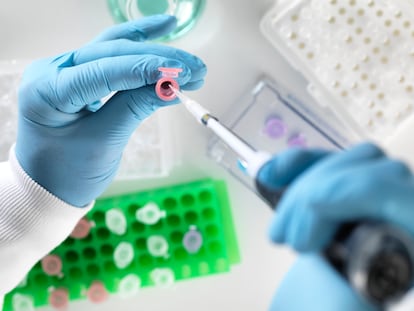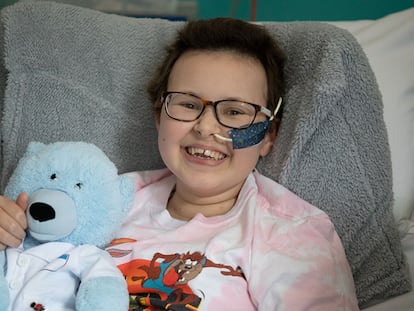With the promise of saving millions of lives, CRISPR medicine is born
The approval of the first DNA editing therapy opens the door to a revolution in the treatment of a multitude of diseases, such as cancer

One day in 1989, an inexperienced 26-year-old scientist was walking through the Santa Pola salt flats. The strange landscape on the Mediterranean coast near Alicante (Spain) is where salt is extracted from the sea in shallow artificial ponds. Microbiologist Francis Mojica was starting a tedious piece of research that would not pique anybody’s interest for decades. He wanted to find out why some microbes were able to survive in the extremely salty water. In 1992, during the summer of the Barcelona Olympics, Mojica discovered surprising repetitions in the DNA of a microorganism from Santa Pola. He named them CRISPR, which stands for “clustered regularly spaced short palindromic repeats.” His partner, Ángeles Román, warned him that CRISPR sounded like a dog’s name, but that funny name gave rise to CRISPR medicine, a global revolution that today promises to save millions of lives.
Mojica’s eureka moment came in 2003. Those repeated sections were a system with which microbes memorized viruses, their enemies. Among these repeated sequences, the Santa Pola microorganisms integrated the genetic material of the invading viruses into their own DNA, like collecting stamps in an album. When the attackers returned, the microbes recognized them thanks to the CRISPR system and sent remote-controlled molecular scissors to destroy them. Mojica’s team published their discovery without realizing its magnitude. In 2012, French biochemist Emmanuelle Charpentier and American chemist Jennifer Doudna announced that the CRISPR mechanism had “considerable potential” to rewrite DNA, including human DNA.
CRISPR medicine was officially born on November 16, when the United Kingdom was the first country in the world to authorize a treatment based on these molecular scissors. The so-called Casgevy therapy is capable of curing two potentially lethal blood diseases: sickle cell anemia and beta thalassemia. The treatment consists of extracting red blood cell precursor cells from the patient, correcting their DNA errors in the laboratory using CRISPR scissors, and reintroducing these crisperized cells into the patients. The effect of the therapy can last a lifetime. Once and done. The European Medicines Agency recommended authorizing Casgevy last Friday.
Charpentier and Doudna won the Nobel Prize in Chemistry in 2020. The new treatment has been developed by the Swiss company CRISPR Therapeutics, co-founded by Charpentier herself, and the American company Vertex Pharmaceuticals. The first person with sickle cell anemia to try the experimental therapy, American Victoria Gray, recounted her ordeal to this newspaper in March. Gray, 38, suffered constant ailments because her deformed red blood cells got stuck in her blood vessels, multiplying her risk of dying from a stroke. “I no longer feel pain nor have I had to be admitted to the hospital, when before I had to go to the hospital every few months,” Gray says.
Casgevy has inaugurated the first generation of CRISPR treatments. It is a still crude tool, but it is promising in disorders linked to errors in a single gene, such as Huntington’s disease, which causes muscle spasms. There are almost a hundred clinical trials underway with experimental CRISPR treatments. Emmanuelle Charpentier’s company has also gotten encouraging results in cancer with so-called CAR-T therapies. These consist of extracting blood from donors, crisperizing their white blood cells to increase their ability to destroy cancer cells, and infusing them into the patient. On December 4, CRISPR Therapeutics announced that it will use this approach against autoimmune diseases, such as lupus.

One of the best scientists in the world, American chemist David Liu, presented base editors, second-generation CRISPR tools in 2016. If the first generation treatments act like scissors, these are more like a pencil with an eraser, capable of erasing a single letter of the DNA and replacing it with another. Alyssa, a 13-year-old British teenager with a very aggressive leukemia, became the first person to benefit from this advance in May 2022. A medical team at University College London used base editors to precisely modify donor white blood cells into universal super white blood cells. Last June, researchers announced that Alyssa was happy at home, in complete remission from her cancer.
On December 8, the United States also authorized the use of Casgevy, with a price of about $2 million per patient. Geneticist Lluís Montoliu is calling for greater efforts to reduce that figure. “My face falls with shame when I have to talk about the price to the patient associations, to whom I have been explaining the great expectations we have of these tools,” Montoliu, president of the Paris-based Association for Responsible Research and Innovation in Gene Editing, laments. “When we finally have therapies, it turns out that they are not affordable.”
Montoliu, a researcher at the National Center for Biotechnology, recalls that Casgevy “is not without problems.” Harvard biologist Luca Pinello warned a year ago that the treatment can induce unexpected mutations in certain DNA, although so far no problems have been detected in patients.
Like Francis Mojica himself, molecular biologist Feng Zhang was in the running to share the Nobel Prize with Charpentier and Doudna. In the fall of 2012, Zhang was the first to use CRISPR scissors to edit the DNA of a mammal. “I think the next significant moment will be the use of CRISPR in vivo. The CRISPR treatment will be injected into the patient, rather than editing the cells in the laboratory. This would represent an important step to reduce the cost of this therapy, increase accessibility, and expand the types of diseases we can treat,” says Zhang, from the Massachusetts Institute of Technology (MIT). “I hope that CRISPR medicine will improve the lives of millions, even billions of people. We must address common diseases, such as cancer, Alzheimer’s, and diabetes. To do this, we need a deeper understanding of the mechanisms that drive these complex diseases and more tools in our therapeutic arsenal,” he adds.
People with sickle cell anemia have sickle-shaped red blood cells, caused by the production of a deformed version of hemoglobin, the protein that carries oxygen through the blood. In 2008 the American doctor Stuart Orkin, from Harvard University, discovered that the gene BCL11A activates production of this deformed hemoglobin and at the same time blocks the creation of functional fetal hemoglobin. Orkin’s team showed that inactivating that gene cured the disease in mice. This is what CRISPR scissors now do in humans.

“The price of new therapies can be high,” says Orkin. “That price must take into account the benefit and the severity of the disease. In the case of sickle cell anemia or beta thalassemia, the lifetime cost of conventional treatments is high, and perhaps in the same range as the price of gene editing therapy. Efforts must be made to reduce the price of treatments of all kinds,” the Harvard doctor says.
Geneticist David Altshuler, chief scientific officer at Vertex Pharmaceuticals, acknowledges the difficulties of treatment with Casgevy. The patient may be hospitalized for about five weeks after receiving the therapy, which requires standard chemotherapy to make room in the bone marrow and reintroduce the edited supercells. “An important discovery would be to develop a pill that can have similar benefits without the need for a bone marrow transplant,” he explains. His company is currently pursuing this very ambitious goal.
The American company Verve Therapeutics, founded in 2018 by cardiologist Sekar Kathiresan, presented the preliminary results of its VERVE-101 therapy on November 12. It is the first CRISPR treatment to edit DNA in the patients themselves, not in cells in the laboratory. The strategy uses base editors to inactivate the PCSK9 gene in liver cells, associated with very high levels of so-called “bad” cholesterol. The therapy managed to reduce this cholesterol by 55% in a dozen patients with dangerous congenital hypercholesterolemia, but one of them died from a heart attack five weeks after receiving the treatment. An independent committee of experts ruled that the death was not related to gene editing.
Harvard University chemist David Liu once again revolutionized the world of gene editing in 2019, by introducing third-generation CRISPR tools, or “quality editors.” They are no longer scissors or a pencil with an eraser. “It’s like a word processor. You can search for a specific sequence and replace the entirety of it with any other sequence you want,” in Liu’s words. The researcher claims that quality editors can, in theory, correct more than 90% of the 75,000 genetic variants associated with diseases. There are 400 million people affected by one of the 7,000 disorders caused by mutations in a single gene. Founder of the company Prime Medicine, Liu considers it feasible to test quality editors for the first time in humans in 2024.
Today, the inexperienced scientist who was walking through the Santa Pola salt flats in 1989 is 60 years old and is a professor at the University of Alicante. Francis Mojica admits that his hair stands on end when he contemplates that CRISPR medicine is already saving lives: “It’s impressive. I still can’t believe it. I’m afraid something could go wrong. It’s all too good to be true.”
Sign up for our weekly newsletter to get more English-language news coverage from EL PAÍS USA Edition
Tu suscripción se está usando en otro dispositivo
¿Quieres añadir otro usuario a tu suscripción?
Si continúas leyendo en este dispositivo, no se podrá leer en el otro.
FlechaTu suscripción se está usando en otro dispositivo y solo puedes acceder a EL PAÍS desde un dispositivo a la vez.
Si quieres compartir tu cuenta, cambia tu suscripción a la modalidad Premium, así podrás añadir otro usuario. Cada uno accederá con su propia cuenta de email, lo que os permitirá personalizar vuestra experiencia en EL PAÍS.
¿Tienes una suscripción de empresa? Accede aquí para contratar más cuentas.
En el caso de no saber quién está usando tu cuenta, te recomendamos cambiar tu contraseña aquí.
Si decides continuar compartiendo tu cuenta, este mensaje se mostrará en tu dispositivo y en el de la otra persona que está usando tu cuenta de forma indefinida, afectando a tu experiencia de lectura. Puedes consultar aquí los términos y condiciones de la suscripción digital.
More information
Últimas noticias
Welcome to the post-religion era: The idea of Christianity as the absolute truth has become obsolete
‘I thought you would like it’: The risky sexual practice popularized by TV shows and TikTok
The digitalization of tourism: ‘They promise experiences and gave us the worst possible one’
Mexican peso defies uncertainty with forecasts of a new period of stability in 2026
Most viewed
- Sinaloa Cartel war is taking its toll on Los Chapitos
- Oona Chaplin: ‘I told James Cameron that I was living in a treehouse and starting a permaculture project with a friend’
- Reinhard Genzel, Nobel laureate in physics: ‘One-minute videos will never give you the truth’
- Why the price of coffee has skyrocketed: from Brazilian plantations to specialty coffee houses
- Silver prices are going crazy: This is what’s fueling the rally











































